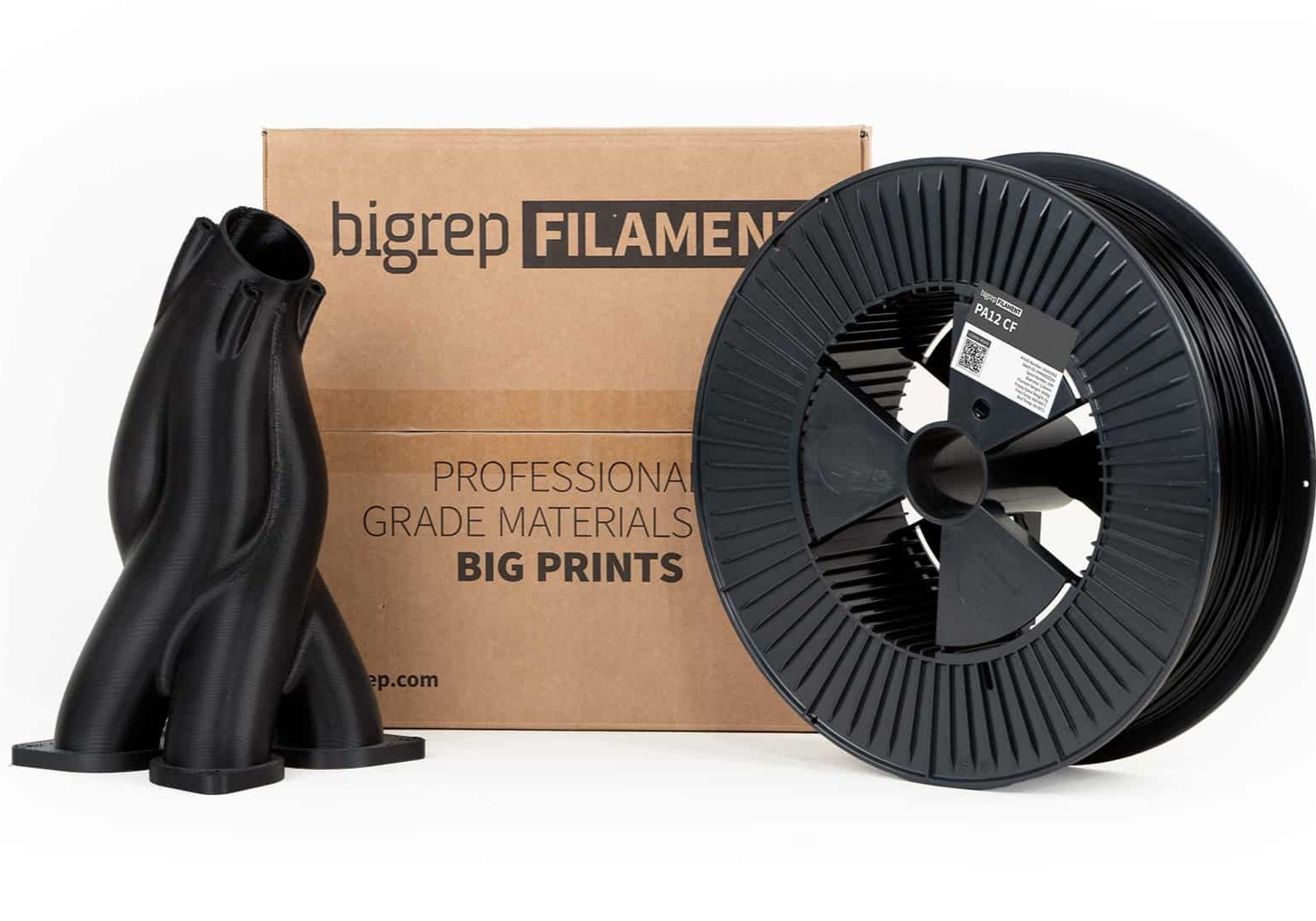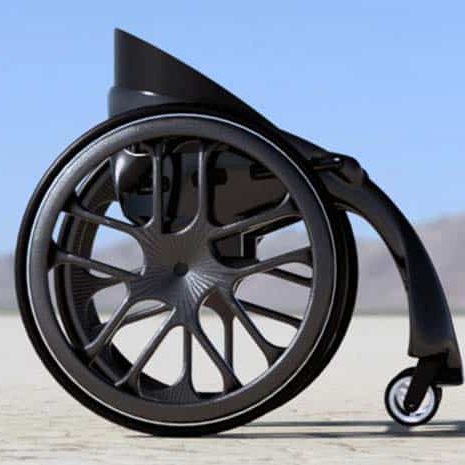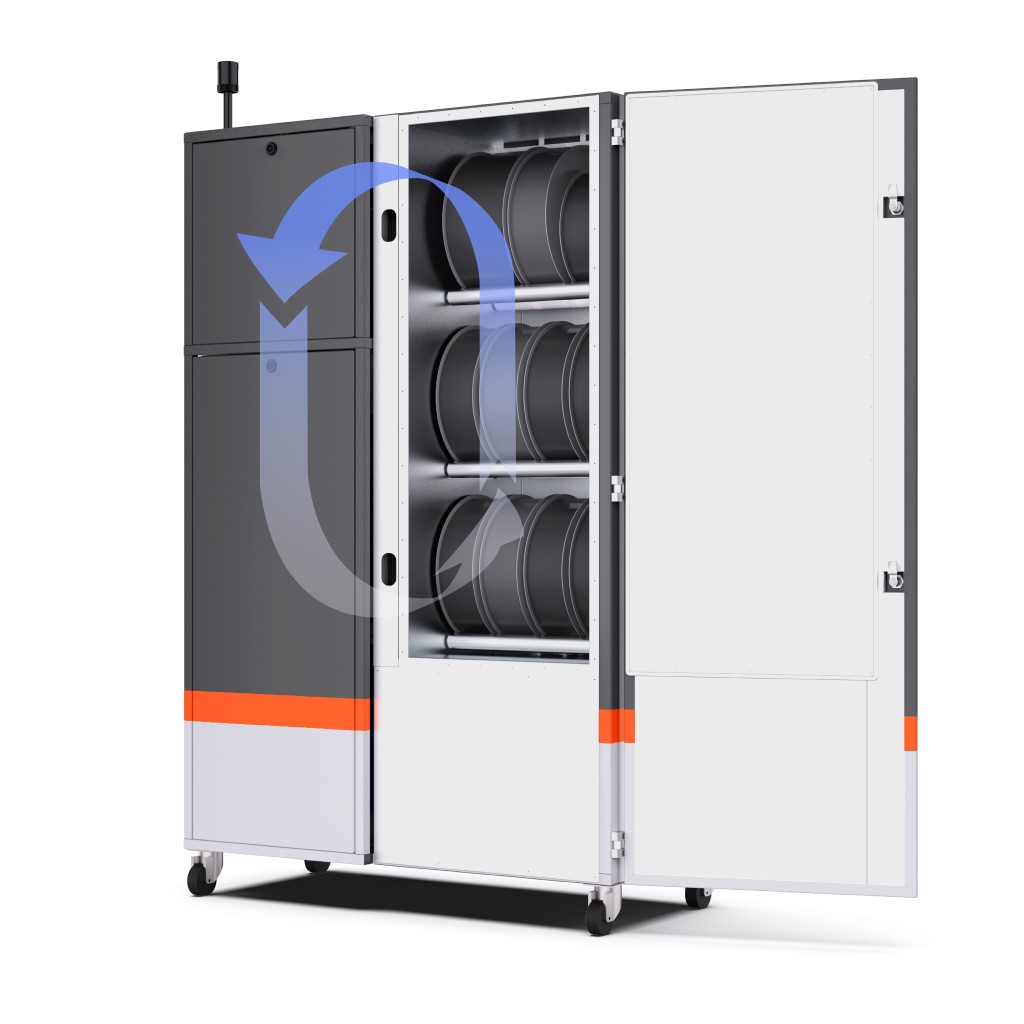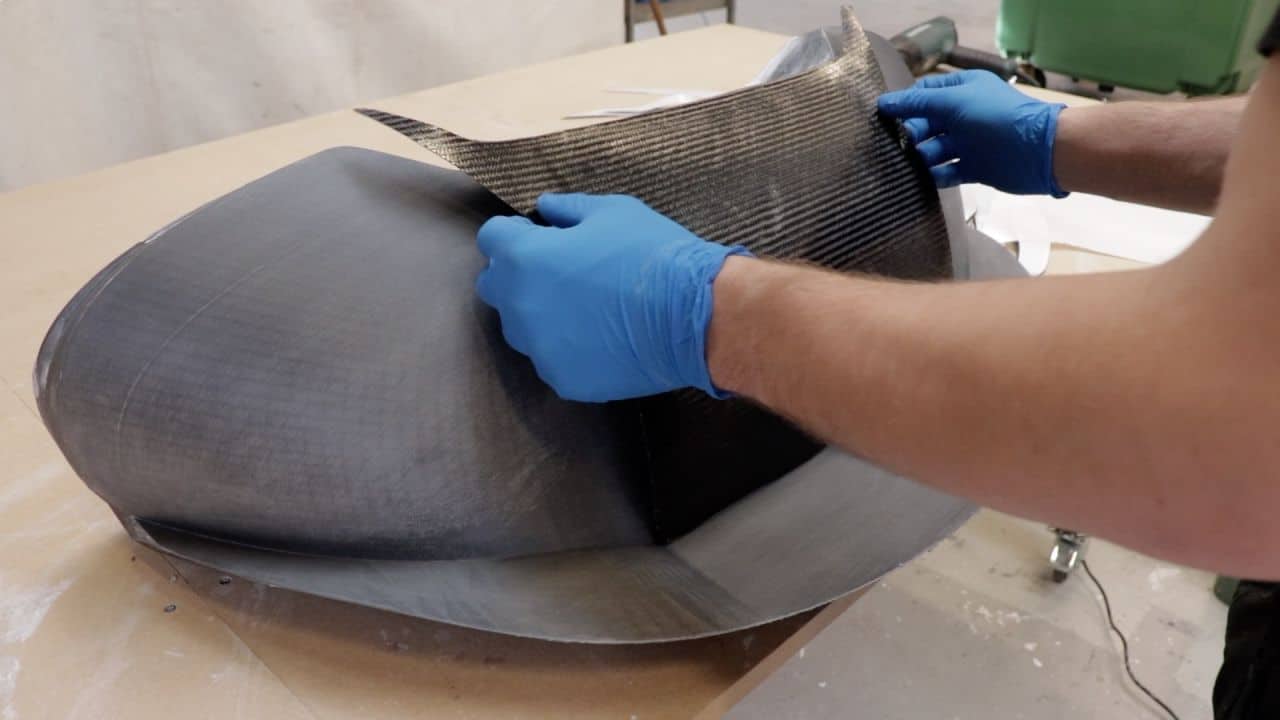
HI-TEMP CF
STARK UND HITZEBESTÄNDIG

VERFÜGBARE FARBEN
HI-TEMP CF von BigRep ist ein stabiles technisches Filament mit hoher Hitzebeständigkeit. HI-TEMP CF besteht zu 10% aus Carbonfasern und ist dadurch noch fester als das HI-TEMP Filament von BigRep.
BigRep HI-TEMP CF kombiniert Haltbarkeit mit Hitzebeständigkeit und ist deswegen perfekt geeignet für funktionale Anwendungen unter schwierigen Bedingungen in industriellen Umgebungen. Dank seiner hohen Festigkeit ist
HI-TEMP CF ideal für 3D-gedruckte Modelle und Formen für verschiedene formgebende Anwendungen.
BigRep HI-TEMP CF ist zuverlässig, leicht zu verwenden, und optimiert für den großformatigen 3D-Druck in BigRep-Maschinen. Teile, die mit diesem Material gedruckt werden, sind leicht und trotzdem steif. Produzieren Sie industrielle Teile
zu einem erschwinglichen Preis.
GEEIGNET FÜR
![]()

![]()

![]()


Steif und
haltbare Teile

Leichte
3D Drucke

Gute
Hitzebeständigkeit

Leicht zu drucken für
diverse Anwendungen

Ausgezeichnete
Oberflächenqualität
Was ist HI-TEMP CF 3D-Druck-Filament?
Bei HI-TEMP CF von BigRep handelt es sich um ein strapazierfähiges thermoplastisches Element, das für seine hohe Hitzebeständigkeit und Langlebigkeit bekannt ist. Das 3D-Druckmaterial besteht aus BioPolymer (einem thermoplastischen Gemisch auf PLA-Basis) und ist mit 10 % gehäckselten Kohlenstofffasern verstärkt. Der Zusatz der Fasern sorgt für zusätzliche Steifigkeit und Festigkeit im Vergleich zum reinen HI-TEMP-Filament von BigRep.
Abgesehen von den oben genannten Eigenschaften weist HI-TEMP CF auch ein gutes Verhältnis von Festigkeit zu Gewicht auf und wurde für die großformatige Extrusion optimiert. Das Filament ist mit vielen BigRep-Systemen kompatibel, einschließlich BigRep ONE, STUDIO G2, PRO und anderen Fused Filament Fabrication (FFF)-Systemen.

Gründe für die Verwendung von BigRep HI-TEMP CF-Filament
Dank der hervorragenden Widerstandsfähigkeit und Wärmeformbeständigkeit des Materials ist das HI-TEMP CF-Filament eine ausgezeichnete Wahl für viele technische und industrielle Anwendungen. Insbesondere eignet sich HI-TEMP CF ideal für die Herstellung von Modellen und Formen, da es den Temperaturen und dem Druck des Thermoformverfahrens sowie den Temperaturen beim Aushärten von Carbonfaser-Prepregs standhält.
Das thermoplastische Filament kann auch industriellen Anwendern in Bereichen wie Automobil, Motorsport und Luft- und Raumfahrt (um nur einige zu nennen) zugute kommen, die von der Kombination aus hoher Hitzebeständigkeit, geringem Gewicht und Langlebigkeit des Materials profitieren. Darüber hinaus zeichnet sich HI-TEMP CF durch eine gute UV-Stabilität aus und kann daher zuverlässig in Außenanwendungen eingesetzt werden.

ENDGENUTZTE
BAUTEILE

PRODUKTIONS-
HILFSMITTEL

FORMEN FÜR
CARBONFASERTEILE

FUNKTIONALE
PROTOTYPEN
Die Vorteile des 3D-Drucks BigRep HI-TEMP CF
HI-TEMP CF bietet eine Vielzahl von Vorteilen für den Anwender. Neben seiner Wärmeformbeständigkeit und seinen strapazierfähigen Materialeigenschaften, die sich hervorragend für anspruchsvolle Anwendungen eignen, ist das Filament einfach zu drucken. Speziell neigt das Filament nicht zum Verformen (obwohl es trotzdem mit einem Bettkleber verwendet werden kann) und besitzt eine hochwertige, matte Oberflächenbeschaffenheit. Dieses hochwertige Finish direkt auf der Bauplattform ist charakteristisch für kohlenstofffaserverstärkte Filamente, die weniger erkennbare Schichtlinien aufweisen. Natürlich lässt sich BigRep HI-TEMP CF mit einer Vielzahl von Methoden nachbearbeiten, um ein noch besseres Finish und höhere Toleranzen zu erzielen.
Die meisten Vorteile und besten Druckergebnisse bei der Verwendung von HI-TEMP CF lassen sich durch die korrekten Druckereinstellungen erzielen.
EMPFOHLENE DRUCKEINSTELLUNGEN
- Düsentemperatur: 210 – 240 °C
- Temperatur des Druckbetts: 50 – 80 °C
- Kammertemperatur: n/a
- Druckgeschwindigkeit: >40 mm/s
HI-TEMP CF ist wahrscheinlich vor allem für seine hervorragende Steifigkeit und Langlebigkeit bekannt. Mit einer Zugfestigkeit von 65 MPa kann das Material erheblichen Belastungen standhalten, ohne zu brechen. BigRep HIGH-TEMP hat im Vergleich dazu eine Zugfestigkeit von 61 MPa, während ABS eine Zugfestigkeit von 30 MPa aufweist. Der Kohlefaserverbundwerkstoff HI-TEMP CF ist mit einer Dichte von 1,20 g/cm³ außerdem sehr leicht.
Wie der Name schon andeutet, wurde bei der Entwicklung von HI-TEMP CF die Hitzebeständigkeit als oberste Priorität festgelegt. Das Filament zeichnet sich durch eine hohe Wärmeformbeständigkeit („Heat Deflection Temperature“, HDT) von bis zu 115 °C aus und übertrifft damit die Hitzebeständigkeit von ABS-, ASA- und HI-TEMP-Materialien. Was die Drucktemperaturen betrifft, so erfordert das Filament eine auf 210 bis 240 °C aufgeheizte Düse, und die besten Druckergebnisse werden mit einem auf bis zu 80 °C aufgeheizten Druckbett erzielt.
HI-TEMP CF gilt als chemisch stabiles Produkt und ist resistent gegen UV-Strahlung. Das auf PLA basierende Material mit Kohlefaserverstärkung ist jedoch anfällig für einen gewissen chemischen Verschleiß: Es wird empfohlen, den Kontakt mit starken Oxidationsmitteln und aggressiven Säuren bei der Nachbearbeitung oder während des Gebrauchs zu vermeiden.
Was ist beim 3D-Druck von BigRep HI-TEMP CF zu beachten?
Beim Druck von BigRep HI-TEMP CF ist vor allem zu beachten, dass das Material durch den Zusatz von Kohlefasern abrasiver ist. Das bedeutet, dass der Druckprozess eine Hochleistungsdüse erfordert, die vorzugsweise aus gehärtetem Stahl besteht. Wenn Sie die Düse Ihres BigRep 3D-Druckers für dieses technische Filament aufrüsten, können Sie die Abnutzung des Hotends verhindern und die Druckergebnisse verbessern.
Obwohl die Verformung beim Druck von HI-TEMP CF kein großes Problem darstellt, können Anwender von der Verwendung von Druckbettklebern profitieren, um die Haftung der ersten Schicht zu verbessern. Es gibt einige Klebstoffe, die mit diesem Filament gut harmonieren, darunter Kapton-Band und Magigoo-Kleber (oder eine Kombination aus beidem). Alternativ dazu funktioniert die abnehmbare und flexible Druckoberfläche SWITCHPLATE von BigRep auch hervorragend mit HI-TEMP CF und erfordert keine zusätzlichen Klebstoffe.
Bewährte Verfahren für die Lagerung und die Handhabung von BigRep HI-TEMP CF
Um die bestmöglichen Druckergebnisse mit HI-TEMP CF zu erzielen, ist es wichtig, die Richtlinien zur richtigen Lagerung und Handhabung zu beachten. Wie viele Filamente ist auch HI-TEMP CF hygroskopisch, d. h. es nimmt Feuchtigkeit aus der Umgebung auf. Das Drucken von „nassem“ Filament kann zu Problemen wie Fadenbildung führen und die Druckqualität beeinträchtigen. Glücklicherweise lässt sich dies durch die Lagerung von HI-TEMP CF-Spulen in einer trockenen Umgebung vermeiden, z. B. im BigRep SHIELD.
Falls Ihre Filamentspule Feuchtigkeit ausgesetzt war, können Sie HI-TEMP CF vor dem Druck auch 4-6 Stunden bei 50 °C trocknen. Zu den weiteren empfohlenen Lagerungsmethoden für das Filament gehört es, dieses vor direkter Sonneneinstrahlung zu schützen und es bei Raumtemperatur zu lagern. Wenn Sie diese Empfehlungen befolgen, hält eine Spule HI-TEMP CF problemlos bis zu 24 Monate.
Was die Handhabung anbelangt, so empfiehlt es sich stets, in einem gut belüfteten Raum zu drucken. Staub und Dämpfe, die beim Druckprozess entstehen, können zu Irritationen führen. Daher ist es wichtig, die richtigen Lüftungsöffnungen oder eine lokale Absaugung zu installieren, insbesondere wenn mehrere Drucker im Einsatz sind. Da HI-TEMP CF hohe Drucktemperaturen erfordert, sollten die Benutzer außerdem in der Nähe des heißen Druckkopfs, des Druckbetts und des geschmolzenen Filaments Vorsicht walten lassen.

Anwendungsfälle: Wie Kunden BigRep HI-TEMP CF nutzen
HI-TEMP CF ist erwiesenermaßen ein vielseitiges Material, das in einer Reihe von Bereichen eingesetzt werden kann. Das Material verfügt über eine hohe Hitzebeständigkeit (bis zu
115 °C) und ist resistent gegen Biegung und Spannungen, was es zu einem vielseitigen Filament macht, das die Anforderungen verschiedener technischer Anwendungen erfüllen kann, von funktionalen Prototypen über Formen bis hin zu robusten Endkomponenten.
Das dänische Luft- und Raumfahrtunternehmen Airflight, das sich auf Drohnen und fliegende Kräne spezialisiert hat, setzt den BigRep 3D-Druck und das HI-TEMP CF-Filament ein, um seine Design- und Produktionsabläufe zu rationalisieren und zu optimieren. In einem Anwendungsfall hat das Unternehmen eine großformatige Drohnenform aus HI-TEMP CF in 3D gedruckt, wodurch es seine Kosten im Vergleich zum herkömmlichen CNC-Fräsen um das Fünffache senken konnte. Der Prozess bestand aus dem 3D-Druck der Form, der Verstärkung mit Füllstoff, der Nachbearbeitung und dem Wachsen des Drucks sowie dem Überziehen mit Kohlefaser-Prepreg. Anschließend wurden die Form und das Kohlefaser-Prepreg versiegelt und bei 100 °C ausgehärtet, sodass ein hochwertiges fertiges Drohnenbauteil entstand. Zusätzlich zu den geringeren Kosten ermöglicht der Einsatz von BigRep 3D-Druck und HI-TEMP CF Airflight, die Vorlaufzeiten zu verkürzen und komplexere Formen zu entwickeln.
Ebenfalls im Bereich der Luft- und Raumfahrt entwickelte der Geschäftsbereich AeroAdditive von SMF Technology eine Haltevorrichtung für Hubschrauberblätter – die erste ihrer Art – unter Verwendung der Technologie von BigRep und HI-TEMP CF-Filament. Das Teil wurde entwickelt, um gefaltete Hubschrauberblätter sicher und stabil zu halten, während sich das Fluggerät an Bord eines Schiffes befindet oder im Stand dem Wind ausgesetzt ist. Die vom Team von AeroAdditive gedruckten Rotorblätter wurden für den Luft- und Raumfahrt- und Verteidigungskonzern Leonardo entwickelt, der leistungsfähigere Halterungen für seine Flugzeuge benötigte. Die Endprodukte, die auf dem BigRep PRO gedruckt wurden und 900 x 230 x 160 mm groß sind, wurden selbstverständlich geliefert. SMF Technology berichtet, dass die gedruckten Halterungen aus HI-TEMP CF die Leistung der Originalkomponenten übertrafen und dass das Material auch die erforderliche Langlebigkeit und Wetterbeständigkeit für die anspruchsvolle Anwendung bot.

Physical properties:
| Material: | BioPolymer mit Kohlefaser |
| Filament/ Spulengröße: | 2,3 kg und 4,5 kg |
| Durchmesser: | 2,85 mm |
| Dichte: | 1,20 g/cm³ |
| E-Modul (ISO 527): | 7000 MPa |
| Zugfestigkeit (ISO 527): | 65 MPa |
| Schlagzähigkeit gekerbt (ISO 179): | 4.5 kJ/m³ |
| HDT / B (ISO 75) (ISO 750): | 115 °C |
| Härte (Shore) (ISO 750):: | na |
EMPFOHLENE DRUCKBEDINGUNGEN:
| Düsentemperatur: | 210 - 240 °C |
| Druckbetttemperatur: | > 50-80 °C |
| Druckgeschwindigkeit: | n.a. |
| Umgebungstemperatur: | > 40 mm/s |
Zusätzlicher Kommentar: Um konstante Materialeigenschaften und Verdruckbarkeit zu gewährleisten, sollte das Filament immer trocken gehalten werden.
